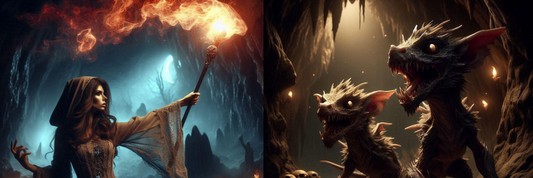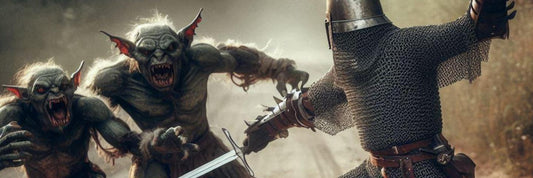Choose Your own Actions! A Beginner's First Scenario of D&D Combat
Welcome to the world of Dungeons & Dragons! Combat in D&D can seem complex at first, but it's incredibly exciting once you get the hang of it. In this blog post, we'll walk you through a combat scenario with a level 1 fighter named Kaldor. This will be a choose-your-own-adventure story, where you decide what actions Kaldor takes in battle. We'll explain the outcomes of each choice based on dice rolls and game mechanics. Ready? Let's dive in!
You’ll want either a set of Polyhedral rpg dice or you can use this online tool from RGB Studios:
https://rgbstudios.org/projects/dnd-dice?m=
Meet Kaldor, the Level 1 Fighter
Before we begin, here are Kaldor's basic stats and equipment:
- Strength: 16 (+3)
- Dexterity: 12 (+1)
- Constitution: 14 (+2)
- Intelligence: 10 (+0)
- Wisdom: 10 (+0)
- Charisma: 8 (-1)
- Armor Class (AC): 18 (Chain Mail and Shield)
- Hit Points (HP): 12
- Weapons: Longsword (1d8+3 slashing damage)
The Scenario: Ambush in the Forest
Kaldor and his companions are traveling through a dense forest when they are ambushed by a group of goblins. Kaldor finds himself face-to-face with two goblins, while his friends are engaged with others nearby.
Round 1: Kaldor's Turn
What will Kaldor do?
- Attack with his longsword.
- Shove a goblin to knock it prone.
- Take the Dodge action to make himself harder to hit.
Option 1: Attack with Longsword
Kaldor swings his longsword at the nearest goblin.
Roll to hit: 1d20 + Strength modifier (+3) + Proficiency bonus (+2) = 1d20 + 5
- If the roll is 10 or higher (Goblin's AC is 15), Kaldor hits the goblin.
-
Damage Roll: 1d8 + 3 (Strength modifier) = 4-11 damage
Result: The goblin has 7 HP. If Kaldor deals 7 or more damage, the goblin falls. Otherwise, it's injured but still fighting. -
If the roll is 9 or lower, Kaldor misses.
Result: The goblin dodges the attack and remains unscathed.
Option 2: Shove a Goblin
Kaldor attempts to shove the goblin, trying to knock it prone.
Shove Roll: 1d20 + Strength modifier (+3) + Proficiency bonus (+2) = 1d20 + 5 vs. Goblin's Athletics (Strength) or Acrobatics (Dexterity)
-
If Kaldor's roll is higher, the goblin is knocked prone.
Result: The goblin is prone, and Kaldor's allies get advantage on melee attack rolls against it until it stands up. -
If the goblin's roll is higher, Kaldor fails to shove it.
Result: The goblin stays on its feet and grins menacingly.
Option 3: Take the Dodge Action
Kaldor takes a defensive stance, focusing on avoiding attacks.
Result: Until the start of Kaldor's next turn, any attack roll made against him has disadvantage if he can see the attacker, and he has advantage on Dexterity saving throws.
Round 2: Goblins' Turn
The goblins retaliate! There are two goblins in front of Kaldor.
What will the goblins do?
- Attack Kaldor with their scimitars.
- Disengage and try to flee.
Option 1: Attack Kaldor
Each goblin swings its scimitar at Kaldor.
Goblin's attack roll: 1d20 + 4 (Goblin's Attack Bonus)
- If the roll is 18 or higher, the goblin hits Kaldor.
-
Damage Roll: 1d6 + 2 = 3-8 damage per hit
Result: Kaldor takes damage. If both goblins hit, Kaldor could take significant damage. -
If the roll is 17 or lower, the goblin misses.
Result: Kaldor's armor deflects the attacks, keeping him safe.
Option 2: Disengage and Flee
The goblins decide it's safer to run than to fight.
Result: The goblins use their action to disengage, moving away from Kaldor without provoking an opportunity attack.
Round 3: Kaldor's Turn
The fight continues! Kaldor has several choices for his next move.
What will Kaldor do?
- Attack a goblin again with his longsword.
- Use Second Wind to regain hit points.
- Try to intimidate the remaining goblins.
Option 1: Attack Again
Kaldor swings his longsword at the nearest goblin again.
Roll to hit: 1d20 + 5
- If the roll is 10 or higher, Kaldor hits the goblin.
-
Damage Roll: 1d8 + 3
Result: Depending on the goblin's remaining HP, it may fall or be further injured. -
If the roll is 9 or lower, Kaldor misses.
Result: The goblin remains standing, ready to fight.
Option 2: Use Second Wind
Kaldor taps into his stamina reserves to heal himself.
Second Wind Roll: 1d10 + Fighter level (1) = 2-11 HP
Result: Kaldor regains HP, boosting his chances of surviving the fight.
Option 3: Intimidate the Goblins
Kaldor tries to scare the goblins into surrendering or fleeing.
Intimidation Check: 1d20 + Charisma modifier (-1)
-
If the roll is high, the goblins may decide Kaldor is too dangerous to fight.
Result: The goblins may flee or surrender, ending the combat. -
If the roll is low, the goblins are not intimidated.
Result: The fight continues, and the goblins may become more aggressive.
Conclusion
Combat in D&D is dynamic and full of choices. This choose-your-own-adventure story demonstrates some basic options available to a level 1 fighter like Kaldor. By understanding your character's abilities and the potential outcomes of their actions, you can make strategic decisions to navigate combat effectively. Remember, D&D is about creativity and fun, so don't be afraid to try new tactics and think outside the box!
Happy adventuring, and may your rolls be ever in your favor!




